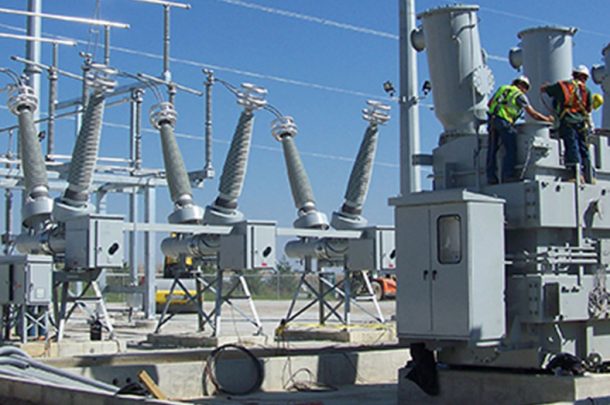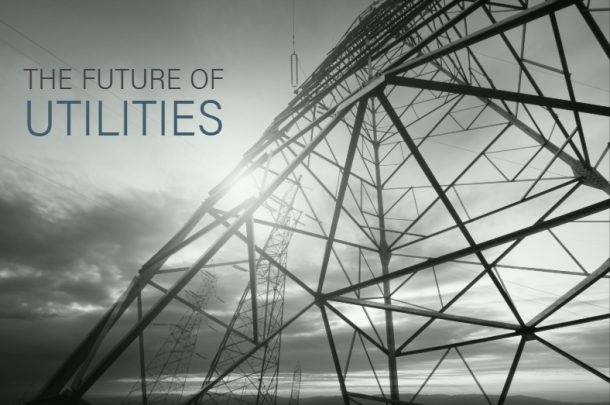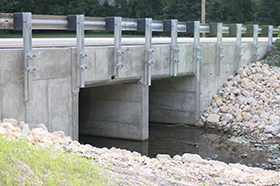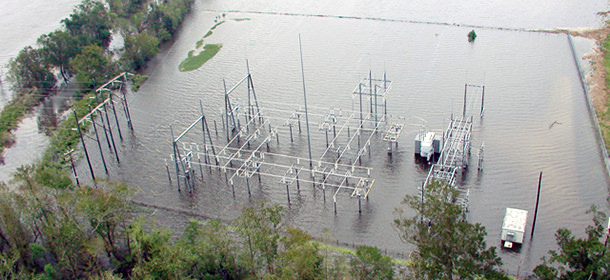
Utility companies manage risk every day, but the most significant risks a utility company will face are those that threaten their reliability. Many utilities are constantly analyzing the reliability of their systems, and making associated infrastructure improvements to that system. An important aspect of managing these risks includes assessing external factors that impact the system, such as the weather. While improving the technology and infrastructure associated with the power grid may help protect against heavy snow and ice or flying debris, a solid flood risk mitigation program can also help address these risks. But why should a utility make investments in protecting against flooding? Many question how standing water can have any impact on those lines so high in the sky.
What some people don’t see is that those lines high in the sky are connected to substations on the ground – an essential component of the power grid. For those with limited background, substations are nodes along the interconnected path of electricity where the strength is stepped up or stepped down in order to pass into transmission lines, distribution lines or directly into a customer-owned site. Substations were often built before flood risk was identified or understood. Likewise, they were often built on low-priced land which came with water nearby. Substations have cables connecting equipment that run in troughs along the ground. Control houses inside these substations contain highly sensitive equipment that must remain dry. While the portion of the grid that an average person looks up at every day seems high and dry, a few feet of standing water can easily take a substation off line, and have damaging trickle-down effects to the other substations connected to the one experiencing flooding.
Given the critical nature of the infrastructure, every utility should investigate the risk of flooding within their system, and make informed choices about the benefits and costs of a flood mitigation program. It seems like an obvious choice to mitigate against floods – build walls, raise equipment, or elevate control houses. However, it’s never that easy to actually do, and there can be challenges to taking mitigation action. Equipment is connected throughout a substation by cabling and wires, and when a single piece of equipment is altered, it impacts everything else that it touches. So when work is being performed, such as pulling new cables or taking equipment off line, this temporarily increases the risk to the reliability of the system. Another challenge to taking mitigation action is that the costs are often significant. It’s expensive to work within a substation because of the large equipment and electrical hazards that exist above and below grade. The best way to manage this challenge is to plan with a mitigation program and investigate options at a site-specific level. It is important to note that one cannot apply a broad brush mitigation approach because each and every site is different and the hazard and consequences to each site are equally diverse. The key is to assess the risk, identify and investigate mitigation options, and then mitigate the risk in the most safe, beneficial and cost-effective manner.
What’s most crucial to a successful flood mitigation program is to assess the risk when things are dry, before there is any pressure to react to an emergency situation. The small investment associated with performing a risk assessment will help a utility communicate to management what the actual risk is and allow them to mitigate said risk when funds are available. If nothing else, it can help the utilities be better prepared to fight the flood when it happens. The issue is often that it can be difficult to set funds aside to plan for something that may or may not actually happen during the year when a utility is focused on preparing for more likely outages from known issues or historical data. Each utility has funding in a variety of areas such as: operations, maintenance, or capital projects. The various groups within the utility are often competing for these funds, and stretching the dollars as far as possible. The key here, again, is to stage the program and start with a low-cost risk assessment. From there, develop a plan for action so that as funds become available, whether through rate increases or other investments in infrastructure, the costs and actions are well-planned for and the benefits documented.
While there are obviously a number of challenges to implementing a flood mitigation program, the benefits to the utility far outweigh these, and make it a necessary undertaking. The most severe consequence of a down substation is the serious outages to customers fed by that substation. When customers lose power, they will at best lose the ability to use their lights, stoves and refrigerators. At worst, they lose their heating or cooling in critical times or, worse yet, access to emergency services. This can result in anything from inconvenienced and unhappy customers to major health issues or even death. The utility will realize this risk through the enormous effort and costs to fix outages, address public relations issues and, in some cases, lost revenue from large or critical customers. Therefore, avoiding outages, and the costs associated with them, is the primary benefit for a utility company.
Ultimately, there is a considerable return on investment when implementing a mitigation program. Studies have shown that for every dollar invested in hazard mitigation, between $3.00 and $4.00 is saved in the future due to the reduction in risk. While the utility will no doubt see the tangible results from these savings, there is also a return on investment that is not measured in dollars. Communities served by the substations with flood mitigation will also reap the benefits. By mitigating the risk, substations stay online and the power stays on in the area, allowing the flooded community to recover faster. Businesses stay powered, basement flooding can be avoided, hospitals and shelters remain operational, and first responders have access to all the tools they need to serve the public.
These benefits can lead to enhanced community relationships and partnerships as well as parts of served communities that may not have otherwise existed. When adhering to permitting requirements to build mitigation projects, a utility may have the opportunity to work with a community to further its own mitigation goals. For example, the offsetting of floodplain storage for a mitigation project can be expanded or other storage options explored that provide a greater benefit to the watershed. The relationship-building that can be accomplished within a mitigation project will prove valuable to both the utility and the community.
It’s often easiest to understand these concepts when illustrated through a real-life scenario. In the Spring of 2013, a severe flood event resulted in millions of dollars of damage for an electric power utility company in northern Illinois when substations were damaged. After starting to undertake various mitigation measures at the impacted locations without much investigation, the utility stepped back and recognized the need for looking at flooding and risk at its 800+ sites in a more comprehensive manner. Primera Engineers partnered with the utility to develop a broad flood mitigation program, which included a detailed prioritization effort around flood risk at its substations, feasibility studies that identified the best mitigation option, and design and construction of selected mitigation options.
In taking action on their mitigation plan, the utility quickly learned that the State, County and Cities they worked with were extremely interested in the work to be done. There were many regulatory requirements at each of these jurisdictional levels to working within a floodplain or other sensitive environmental area, such as wetlands. In-person meetings with every level of government from early project planning to pre-application meetings to follow-up meetings were key to successful implementation of these projects. In working with one County, the utility agreed to provide surplus compensatory storage over what was needed for the floodplain storage being lost due to the project. There is Transmission Right-of-Way (ROW) adjacent to a flood storage area in development by the County. The utility will now be able to add on to that storage area by leveraging its own land to further expand the flood storage within the watershed. As mentioned previously and demonstrated here, partnerships like this between utilities and communities can be mutually beneficial to both parties, as well as the customers that they both serve.
In summary, a private electric utility that creates a flood mitigation program will no doubt bring resilience to itself, to the power grid, and to the communities that are served by that utility. The efforts by electric utilities to upgrade and protect critical power infrastructure from risks, including flood risks, keep the lights on in communities during severe storms and flooding and, most importantly, keep their customers safe
REFERENCES
“Natural Hazard Mitigation Saves: An Independent Study to Assess the Future Savings from Mitigation Activities.” National Institute of Building Sciences (NIBS), December 2005.






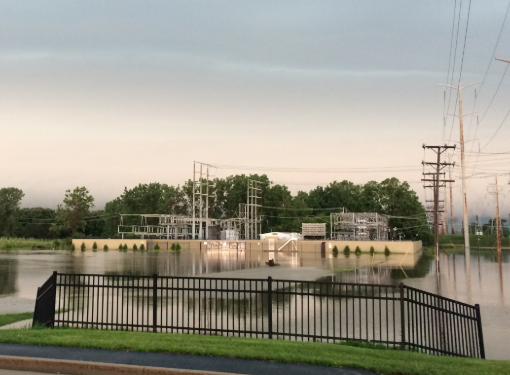
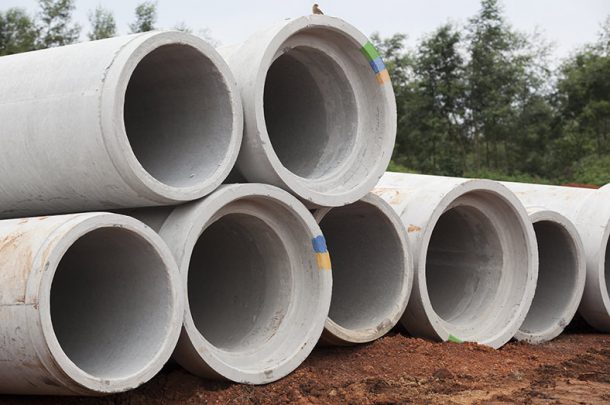
 Integrating Stormwater and Pavement Designs
Integrating Stormwater and Pavement Designs 
